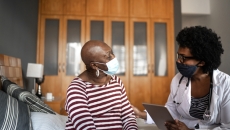Patient Engagement
HIMSS21
Engaging more with user bases and thinking of patients as consumers is a necessity in competing for attention with streaming giants.
HIMSS21 Digital
Some of these changes have presented opportunities for entrepreneurs and product developers.
The COVID-19 pandemic has resulted in a sense of isolation for many, which underscores the importance of humanization.
HIMSS21
Valerie Monet of Banner Health and Kristi Roe of Medallia speak during the Patient Experience Forum at HIMSS 21 in Las Vegas.
HIMSS21
Technology can enhance the patient experience, but it requires organizational buy-in and an infrastructure that scales.
HIMSS21
Telehealth and other new technologies are putting the patient first, improving outcomes and lowering the cost of care.
HIMSS21 Digital panelists will discuss what empathy looks like in practice in a hospital setting during a public health emergency.
SPONSORED
Healthcare organizations that can provide customer-centric healthcare will be better positioned to earn patients' trust, say Sitecore's Jill Grozalsky Roberson and Perficient's Stephen Tynes.
Some of these changes have presented opportunities for entrepreneurs and product developers.
Its platform proactively matches patients with helpful programs, without a manual search, and enrollment is automated.










